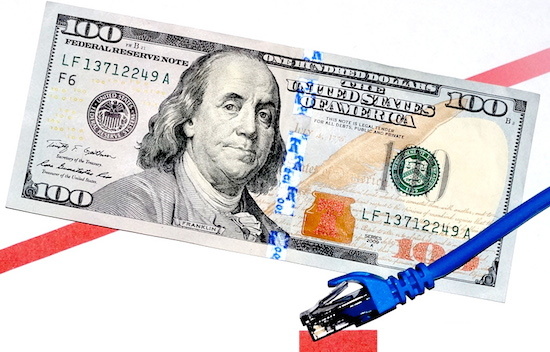There has been a great deal of political sturm und drang in political circles about the yawning income inequality gap, which is now the highest its been in the U.S. since 1928.
But three disparate events got me thinking about one possible cause of that income divide -- the digital divide.
First there was my meeting with MagicJack's new COO, Tim McDonald. You know MagicJack -- that $3/month phone service. Despite that truly magical bargain, which requires a broadband Internet connection, the service has "only" 3 million subscribers.
Second, I got an email from a friend asking me about how many HDTVs there were vs. analog TVs. When I discovered the number, I was kind of shocked - nearly a third of all TVs in the U.S. are still clunky 4:3 analog.
A third?
And, third was a story in the March 13 edition of New York Daily News. Because of damage to underground copper telephone lines as the result of local flooding, Verizon customers in East Harlem have been without landline phone service for more than a month.
Instead of instituting expensive repairs to old technology, Verizon wants to convert all these customers to fiber optic FiOS triple play TV/Internet/phone service.
But 63-year-old Patricia James spoke for a lot of folks when she asserted: "I don't have no computer. I don't want my TV hooked up with nothing."
And therein lies the problem. How can the digitally disadvantaged hope to get ahead when they can't participate in the modern broadband society?
Not surprising (but still depressing) digital statistics
Not surprisingly, the broadband gap and the income gap look nearly identical.
According to Pew, while 88 percent of those with annual household incomes of $75k-plus have broadband, only 54 percent of those households with annual incomes less than $30k do.
And while 74 percent of white households have broadband, only 64 percent of African-Americans and 53 percent of Hispanic do.
Perhaps more depressing is that 20 percent of Americans -- more than 63 million people -- have neither home broadband nor a smartphone. Since the poverty rate is "only" 15 percent -- 46.5 million people -- the digital gap yawns far wider than the income gap.
Broadband equals bucks
But is there a statistical connection between income and a broadband connections?
Oh yeah.
Late last year, Ericsson released "Socioeconomic Effects of Broadband Speed: a Microeconomic Investigation," a study designed to measure the impact of broadband connectivity on income worldwide.
While the report reported a marked effect on incomes in developing BIC (Brazil India China) countries -- $800 more a year with just half a megabit per second (Mbps) service,
[t]he greatest expected increase in [developed country] income is when households go from having no broadband to 4 Mbps, gaining around USD 2,100 per household per year.
Perhaps a bit more surprising, the Ericsson report reports that "[h]ouseholds in advanced economies can achieve more from broadband upgrades."
[S]everal previous studies have shown that broadband enables people to become more informed, better educated, and enriched -- ultimately leading to a faster career path. However as [information and communication technology] maturity increases, participants without broadband or with slow broadband at home will find it harder to stay competitive in the labor market -- reducing their chances of finding a job and building capital. The level of broadband speed required to gain a competitive advantage in the labor market is likely to be raised over time. This labor market competition effect could explain why broadband thresholds seem to be progressing.
In other words, people who have broadband data connections get more opportunities to make more money; ergo, the more people who have broadband connections, the more bridgeable the income gap.
Yeah, I know. That's a bunch of over-simplistic crap. Who actually would think simply getting everyone broadband could help level the income playing field?
Lots of people, actually. But no one can figure out how to accomplish this laudable goal.
Bi-partisan broadband?
President Obama's 2008 "The Blueprint For Change" campaign plan is riddled with references on deploying nationwide broadband. The resulting plan, "Connecting America: The National Broadband Plan," unveiled on March 16, 2010, called for bringing 100 Mbps service to 100 million U.S. homes by the end of this decade.
Uh huh. Cue the rainbows and unicorns.
While it was planning the plan, the FCC launched Broadband.gov, to support the effort.
Except, the last time it was updated was July 23, 2012.
Of course, Congress can't agree on how -- or even attempt -- to foot the billions of tax-payer dollars wiring America with broadband will cost.
So fiscal conservatives founded Broadband for America, which:
promotes well-informed public policy choices to create the right incentives for the private sector to build advanced networks and offer innovative services throughout the Nation, and to encourage all Americans to adopt and use the broadband Internet...
While the nearly 300-member BFA generally supports the President's goals, its private sector efforts are unevenly ad hoc.
Then, last week, Newsweek reported the nation's telecom giants, who have been squirrelling away fees to help finance the nationwide wiring plan, decided it was too expensive. Further, Newsweek says, the telecoms are writing state legislation to make their broadband desertion legal.
So much for the private sector.
Perhaps, some suggest, the best broadband plan is no broadband plan at all. Back in 2012, the Wall Street Journal's Arik Hesseldahl cynically suggested that:
Demographics have a way of shifting over time. Old people who don't bother with broadband will die, and younger people who can't imagine living without it will either demand it where they live or move to places where they can get it.
Unless those younger people are poor and/or non-white, which leaves us right where we are, deep in our digital divide doo-doo.
